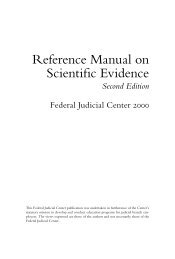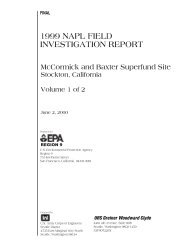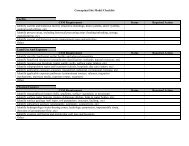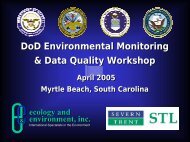Source Zone Delineation Demonstration Report - Triad Resource ...
Source Zone Delineation Demonstration Report - Triad Resource ...
Source Zone Delineation Demonstration Report - Triad Resource ...
Create successful ePaper yourself
Turn your PDF publications into a flip-book with our unique Google optimized e-Paper software.
5.2.3 Vapor Transport ModelingThe TCE time-series data collected during the OU 12 SVE demonstration were compared with simulatedtime-series data using a theoretical distribution of TCE mass in the zone of influence and a sequentialforward numerical modeling scheme in an attempt to help delineate source-zone contamination in thevadose zone of the investigative area. A three-dimensional, finite-difference code for simulatingisothermal vapor flow and transport of multicomponent mixtures called VENT3D [Benson, 1998] wasused for the simulations. As discussed in Section 4.0 of this report, VENT3D solves the threedimensionalvapor phase advective and/or dispersive flux of multicomponent mixtures using anorthogonal grid. Any number of vapor extraction and injection wells can be simulated, and grid-variableinitial permeability and contaminant distributions can be specified. The equilibrium four-phasedistribution of each compound in the mixture is solved in VENT3D between time steps, facilitating theexplicit solution of the time-variable retardation of the various compounds. During the OU 12 SVEsimulations, a third-order, Courant-number-weighted (Total Variation Diminishing [TVD]) algorithm wasused for increased accuracy.The simulation grid used for the SVE modeling was 230 feet long (x-direction), 240 feet wide (ydirection),and 70 feet deep (z-direction). The grid block spacing was constant at 5 feet in all directions.The x-direction contained 46 grid-blocks, the y-direction contained 48 grid-blocks, and the z-directioncontained 14 grid-blocks. The top and side layers of the simulation grid were assumed open to both airand chemical movement; the bottom layer was assumed closed (i.e., zero-flux boundary). The bulkdensity of the soil was assumed to be 1.9 kg/L with an average porosity of 30% and fractional organiccarbon content of 0.001 mg/mg. The average water saturation was assumed to be 1% for the top 20 feetof the modeling domain (corresponding to the upper sandy gravel zone) and 10% for the bottom 50 feet(corresponding to the lower sandy-silt and silty-sand zones). The longitudinal dispersivity was assumedto be 100 cm with an average vertical permeability 10% the value of the horizontal permeability. Thechemical properties of TCE used during the simulations included a molecular weight of 131.4 g/mol,solubility of 1,100 mg/L, and octanol/water partitioning coefficient of 242; boiling point and vaporpressure at 20 C of 86.7 C and 0.076 atm, respectively; liquid density of 1.46 kg/L; and free-airdiffusion coefficient of 0.084 cm 2 /sec.The construction of detailed vapor transport models almost always requires the input of severalparameters that have not been measured (e.g., dispersion coefficients or partitioning coefficients). Inaddition, the calibration process often requires adjustment of parameters to achieve a fit between actualand simulated data. That process is very time consuming and requires considerable judgment based onexperience. Thus, since this sequential forward modeling exercise was conducted in an attempt todemonstrate the applicability of using vapor-phase contaminant concentrations to delineate a suspectedsource in the vadose zone, it was decided to use a simple two-layer permeability field for the simulations.The first permeability layer was comprised of the bottom 50 feet of the modeling domain (correspondingto the lower sandy-silt and silty-sand zone) with an assumed permeability ranging from 0.1 to 100 Darcy.The second permeability field was comprised of the upper 20 feet of the modeling domain (correspondingto the upper sandy gravel zone) with an assumed permeability of 5 to 10 times greater than the lowerMarch 2003 5-56 OU 12 <strong>Demonstration</strong> <strong>Report</strong>Final










